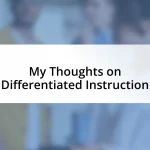Key takeaways:
- Peer teaching enhances understanding and retention by allowing students to explain concepts to each other, fostering a rewarding cycle of knowledge sharing.
- It improves communication skills through active listening and adapting explanations, creating more effective and empathetic dialogues.
- This collaborative approach boosts student engagement and motivation, making learning a dynamic and participatory experience.
- Peer teaching cultivates critical thinking as students analyze and defend different viewpoints, enhancing their reasoning skills and promoting deeper understanding.

Understanding peer teaching benefits
Understanding the benefits of peer teaching can really reshape how we view learning. I remember a time when I struggled with a complex math concept in school. It was a peer who took the time to explain it to me in a way that just clicked. That moment made me realize that sometimes a fellow student can explain things in a simpler, more relatable way than a teacher who’s bound by curriculum constraints.
One of the most enriching aspects of peer teaching is the mutual learning it fosters. When I had the chance to teach a friend about a topic I was passionate about, I found that solidifying my own understanding deepened my knowledge. Isn’t it fascinating how teaching someone else can often provide greater insights than studying alone? This dynamic creates a rewarding cycle of sharing knowledge and reinforces concepts for both parties involved.
Moreover, the emotional benefits of peer teaching shouldn’t be overlooked. I’ve seen how students gain confidence when they help others. It’s not just about academic achievement; it’s about building relationships and creating a support network. Have you experienced the joy of seeing a peer succeed because of your guidance? Those moments highlight the powerful impact of collaboration and connection in our learning journeys.

Enhancing communication skills
When engaging in peer teaching, I’ve noticed that it creates a unique platform for enhancing communication skills. Explaining concepts requires clarity and precision, which pushes us to articulate our thoughts more effectively. I recall a time I was explaining a science experiment to a classmate, and I quickly realized how adjusting my language to simplify complex terms made our conversation not only smoother but also more enjoyable. This experience highlighted how peer teaching fosters a more open dialogue between students.
- Peer teaching encourages active listening, as one must not only speak but also respond to questions and feedback.
- It instills empathy, as you begin to understand your peer’s struggles and adapt your communication style accordingly.
- Engaging with different perspectives sharpens your ability to convey ideas in various ways, enriching your vocabulary and expression.
- I learned to read non-verbal cues during these sessions, allowing me to better gauge understanding and adjust my teaching approach on the fly.
- Ultimately, teaching one another becomes a collaborative dialogue that enhances mutual respect and understanding—key elements of effective communication.

Boosting student engagement levels
One of the most powerful outcomes of peer teaching is how it naturally boosts student engagement levels. I vividly remember a workshop where students were tasked to teach each other specific historical events. The excitement in the room was palpable—students were not just passive recipients of information; they were dynamic participants. When students take charge of teaching, their interest levels skyrocket, fueling a sense of ownership in their learning process.
Moreover, there’s something uniquely motivating about learning from peers. I’ve observed that when classmates break down complex subjects for one another, it ignites curiosity and drives deeper discussions. Instead of viewing the subject matter as a chore, students begin to engage with the material actively. It’s as if a spark of collaborative energy transforms the classroom into a vibrant learning community.
To put it simply, when learning shifts from traditional teacher-led approaches to peer-centric interactions, students tend to feel more connected and part of the educational journey. I recall an instance where my friends and I formed study groups. The atmosphere was lively, and each of us brought our strengths to the table, leading to innovative insights we might not have generated individually. This peer interaction creates an enriching environment, fostering not just engagement but a sense of belonging as well.
| Peer Teaching | Traditional Teaching |
|---|---|
| Encourages active participation | Passive listening |
| Promotes collaboration | Individual work |
| Fosters a sense of community | Isolated learning |

Fostering collaboration among peers
Creating an atmosphere of collaboration among peers is something I’ve seen transform classrooms into dynamic learning spaces. I remember a group project where we broke down a challenging math concept together. The moment my teammates and I started sharing our different problem-solving techniques, I felt the walls of isolation crumble. We weren’t just sharing answers; we were actively bringing our unique perspectives into the mix, which made the process not only effective but also enjoyable.
Collaboration fosters trust, and trust is the glue that holds effective peer teaching together. I still reflect on a time when a close friend and I partnered for a presentation. We struggled at first, but as we respectfully shared feedback and worked through our ideas, it dawned on me how much this shared responsibility strengthened our bond. I can’t help but ask: how often do we miss out on forming these connections in traditional learning settings?
What excites me most about peer collaboration is that it creates a sense of shared ownership. I recall leading a study group for an exam, where we divided topics based on strengths. As we presented to each other, I could see the energy in the room rising—everyone was engaged. It occurred to me that when we take ownership of our learning, we’re not just learning for ourselves, but for each other. This shared journey isn’t just about academic success; it’s about growing together and learning from one another’s strengths.

Improving academic performance outcomes
Peer teaching undeniably enhances academic performance outcomes. I’ve seen firsthand how explaining concepts to classmates not only reinforces my understanding but boosts theirs as well. I remember preparing for a chemistry exam with a friend, and as I explained electron configurations, the light bulb moment for her was like a small victory for both of us.
Engaging in peer teaching builds solid comprehension skills. I once partnered with a classmate who struggled with literature interpretations. As we dissected the themes together, I found that articulating my thoughts helped clarify my own ideas. It’s fascinating how the act of teaching often leads to a deeper grasp of the subject—almost like uncovering layers in a complex puzzle.
The results of peer teaching speak for themselves—students often achieve higher grades and demonstrate improved retention of knowledge. When I volunteered as a peer tutor, I was amazed at how students who participated actively in these sessions outperformed their peers on exams. Have you ever experienced that moment when hard work turns into success? It’s incredibly fulfilling to see that the collaborative efforts not only uplift individual performance but create a ripple effect in the entire learning environment.

Developing critical thinking abilities
Developing critical thinking abilities
Engaging in peer teaching dramatically enhances critical thinking skills. I distinctly remember a time when, during a study group, we were tasked with analyzing a historical event from different perspectives. As we debated and defended our viewpoints, I felt my analytical skills strengthening; I was no longer just passively receiving information, but actively questioning and reasoning through complex ideas. Isn’t it fascinating how discussing opposing views can sharpen our thought processes?
Each time I explored a topic with my peers, I discovered new angles I’d never considered before. I recall when a friend challenged my interpretation of a philosophical text; it sparked a profound discussion that pushed me to dig deeper into my own beliefs. This back-and-forth not only honed my ability to articulate my stance but also taught me the importance of considering other perspectives. How often do we let our own biases limit our understanding?
Through peer teaching, I realized that critical thinking isn’t just about analyzing facts; it’s also about learning to navigate disagreements. When I facilitated a group discussion on a challenging scientific concept, I was struck by how our diverse opinions led to richer insights. Each moment of uncertainty and debate was an opportunity for growth, as we transformed confusion into clarity together. It made me wonder: what larger worldviews have we yet to uncover by simply engaging with one another?

Creating a supportive learning environment
Creating a supportive learning environment is key to fostering confidence among students. I remember when I volunteered at a local tutoring center. The first time a shy student opened up about her difficulties, I could genuinely feel the tension lift. It was like watching a flower bloom; when students know they’re in a safe space, they’re more willing to explore ideas and ask questions. Don’t you think that kind of openness is essential for true learning to occur?
The atmosphere in a peer teaching setting can be transformative. Everyone participates, and there’s an inherent sense of camaraderie that builds respect among peers. I found that sharing successes and struggles made us all feel more connected. One memorable group project had us collectively working through frustrations while celebrating small victories. In that moment, I realized—how powerful it is to learn together and be there for one another.
Supportive learning doesn’t just happen; it’s cultivated. I’ve seen how a simple gesture, like acknowledging a student’s effort or giving constructive feedback, can make all the difference. There was a time when I commended a peer for their progress on a challenging assignment. The gratitude they expressed reminded me just how impactful our words can be. Have you ever thought about how a little encouragement can spark a greater desire to learn?














